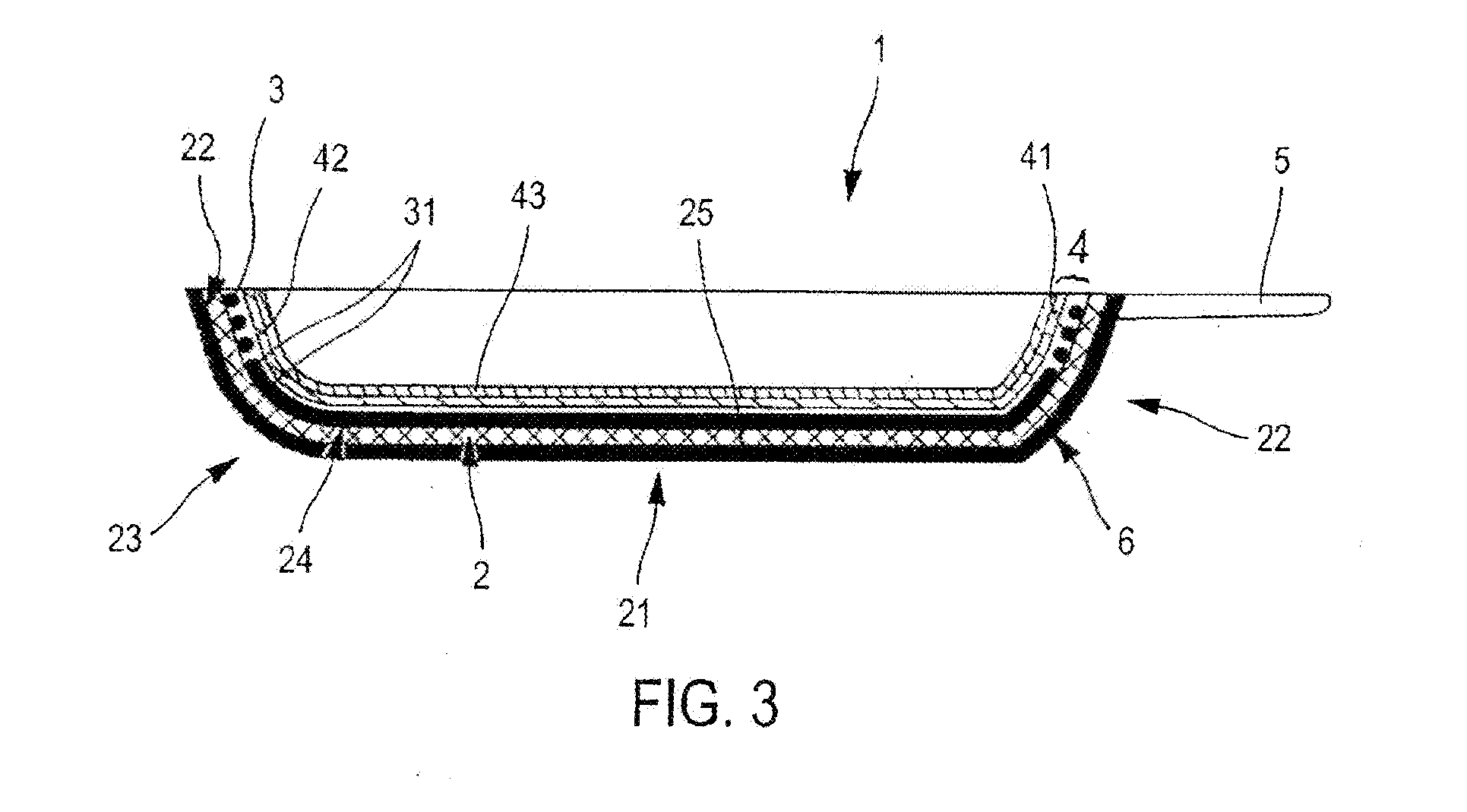Cooking Utensil Comprising a Hard Base Made from Ceramic and/or Metal and/or Polymer Material and a Nonstick Coating Containing a Fluorocarbon Resin
- Summary
- Abstract
- Description
- Claims
- Application Information
AI Technical Summary
Benefits of technology
Problems solved by technology
Method used
Image
Examples
examples
Operating Procedure
[0080]Equipment: CASTOLIN DS 8000 torch with nozzle diameter 30 mm[0081]Twin 20 Sulzer-Metco powder dispenser[0082]Gas propellant: argon or air 4 Nl / min[0083]Combustible gas: acetylene 14 Nl / min Oxygen 31 Nl / min[0084]Temperature of the support during the application of the hard base: greater than or equal to the ambient temperature (of a magnitude of 20-25° C.) and preferably greater than or equal to 200° C. for a ceramic powder[0085]Spraying time: from 0.5 to 20 s for a frying pan 26 cm in diameter[0086]Application of the PTFE: via gun spraying (with a roller or via screen printing)
example 1
Cooking Utensil According to the Invention with a Discontinuous Ceramic Hard Base
[0098]An aluminum disk 3003 of diameter 330 mm is degreased then brushed in order to obtain a roughness Ra of 1.5 μm. This disk is preheated to a temperature between 150° C. and 200° C.
[0099]The torch is used to apply a ceramic powder constituted of an alumina / titanium dioxide mixture (at the rate of 87% alumina and 13% titanium dioxide) in order to obtain a discontinuous deposit across the entire surface of 1.5 g and a roughness of 4 μm.
[0100]This disk prepared as such is successively covered with a primary layer and a top layer with a PTFE base.
[0101]After baking at 415° C., the disk prepared as such is stamped in order to produce a bowl with a bottom of diameter 26 cm, interiorly coated with PTFE (nonstick coating).
[0102]This coating does not have any cracks, or losses of adhesion.
[0103]After an aging of three 3-hour cycles in contact with boiling water, the adherence measured using a surface grid is...
example 2
Cooking Utensil According to the Invention with a Discontinuous Ceramic Hard Base
[0106]An aluminum bowl 3003 of diameter 260 mm is degreased and sandblasted in order to obtain a roughness Ra of 2 μm. This bowl is preheated to a temperature between 150° C. and 200° C.
[0107]The torch is used to apply a ceramic powder of the alumina / titanium dioxide type (87% / 13% respectively) in order to obtain a discontinuous deposit of 0.9 g and a roughness Ra of 3.5 μm.
[0108]After cooling this bowl prepared as such is successively covered with a primary layer and a top layer with a PTFE base.
[0109]The coating is sintered at a temperature of 415° C. for 7 minutes.
[0110]After cooling, the coating does not have any cracks, or losses of adhesion.
[0111]After an aging of three 3-hour cycles in contact with boiling water, the adherence measured using a surface grid is equal to 100%.
[0112]This type of bowl is also tested for its resistance in the dishwasher: after 20 washing cycles, the coating does not ha...
PUM
 Login to View More
Login to View More Abstract
Description
Claims
Application Information
 Login to View More
Login to View More - R&D
- Intellectual Property
- Life Sciences
- Materials
- Tech Scout
- Unparalleled Data Quality
- Higher Quality Content
- 60% Fewer Hallucinations
Browse by: Latest US Patents, China's latest patents, Technical Efficacy Thesaurus, Application Domain, Technology Topic, Popular Technical Reports.
© 2025 PatSnap. All rights reserved.Legal|Privacy policy|Modern Slavery Act Transparency Statement|Sitemap|About US| Contact US: help@patsnap.com



